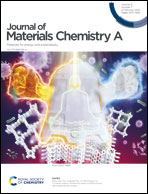P-block tin single atom catalyst for improved electrochemistry in a lithium–sulfur battery: a theoretical and experimental study†
Abstract
Main group metals are routinely considered as catalytically inactive. Hence, they are never employed for optimizing lithium-sulfur electrochemistry. Herein, density functional theory calculations reveal that atomically dispersed tin on a nitrogen-doped carbon substrate is expected to be highly active for electrocatalysis because of the activation of underfilled p orbitals and a significant shift of the p band center towards the Fermi level upon metal–support interaction. Under theoretical guidance, we prepared a p-block tin single atom catalyst (SnSA–NC) with Sn–N4 as the active site for effectively improving the lithium–sulfur battery performance. The charge transfer between the Sn atom and N ligands creates a highly polar site that exhibits strong adsorption capability towards the electrolyte-soluble long-chain polysulfides. The unique p band structure of the central Sn atom modulates the energy barriers for the rate-determining steps of sulfur redox, thus facilitating the lithium polysulfide conversion. Besides, the exposure and utilization of Sn–N4 sites are maximized by virtue of the 13 nm thick nanosheet morphology of the carbon substrate. Remarkably, the functional separator modified by SnSA–NC increases the sulfur utilization by 79.7%, and endows the lithium-sulfur cells with significantly enhanced cyclability and rate performance. This work successfully expands the employment of main group metals for electrocatalysis applications.



 Please wait while we load your content...
Please wait while we load your content...